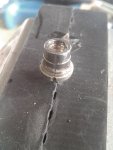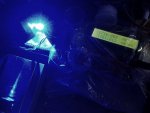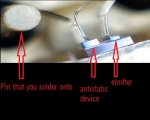- Joined
- Feb 21, 2016
- Messages
- 475
- Points
- 0
hello everyone yesterday i was testing a NUBM08 diode and i accidently the can popped out while i was removing the diode from the heatsink,we all know how this diodes tend to degrade after some time if you take the can off but this weird idea and question came to my mind,what will happen if i seal the can back? :thinking:
i used some super glue to seal the can again to the diode

and after that i made a power test at 1.5A

i'll update the thread once a week with a new power test to see if the degradation will stop at some point or will continue till death.
purpose of the test and usefull info: i expect that the diode will degrade but after that im curious to see if will stop at some point,if the theory proves correct it will be awesome if some of us have lets say a deccaned diode that starts to degrade and we dont want to lose it completly yet,maybe the reseal gives some more time or save the diode from complete death.lets see
edit,updating results:
started:1761mw
week 1:1661mw
week 2:1668mw
week 3:1737mw
week 4:1739mw
after 2 months total time:1434mw
after 5 months total time:1426mw (seems the degradation have stopped at this point)
i used some super glue to seal the can again to the diode
and after that i made a power test at 1.5A
i'll update the thread once a week with a new power test to see if the degradation will stop at some point or will continue till death.
purpose of the test and usefull info: i expect that the diode will degrade but after that im curious to see if will stop at some point,if the theory proves correct it will be awesome if some of us have lets say a deccaned diode that starts to degrade and we dont want to lose it completly yet,maybe the reseal gives some more time or save the diode from complete death.lets see
edit,updating results:
started:1761mw
week 1:1661mw
week 2:1668mw
week 3:1737mw
week 4:1739mw
after 2 months total time:1434mw
after 5 months total time:1426mw (seems the degradation have stopped at this point)
Attachments
Last edited:









